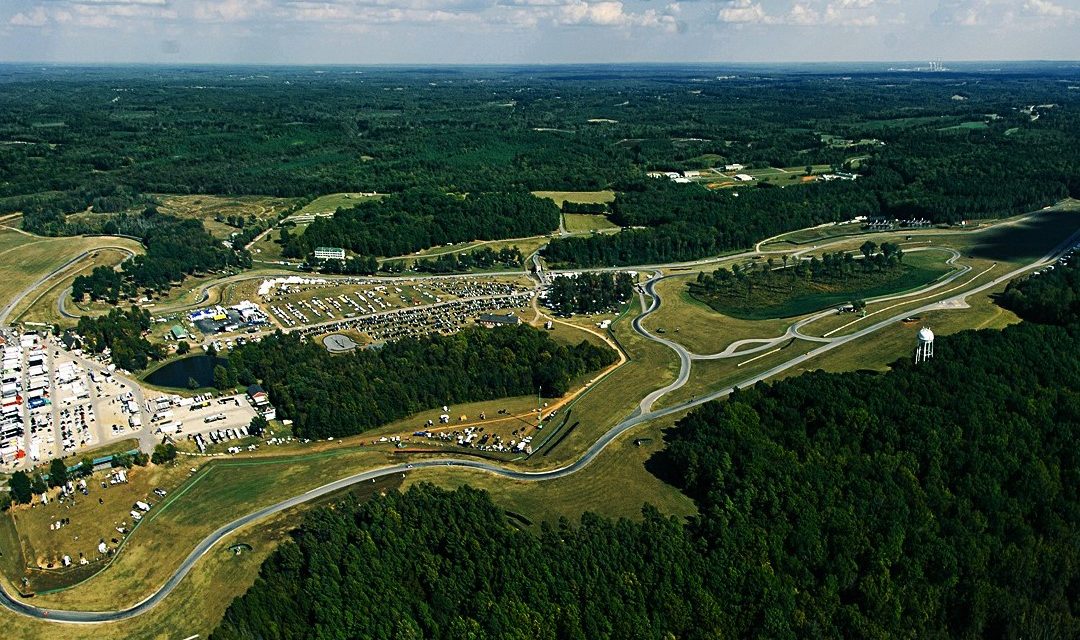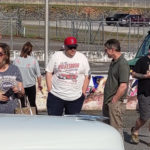By Patrick Reynolds
How does someone raised on NASCAR stock cars fit into IMSA sports car racing?
Quite nicely, if the oval tracker gives road racing a chance.
Despite being located fairly close to my Charlotte area home I made my first visit to VIRginia International Raceway to see IMSA’s GT Le Mans and Daytona machines, along with support classes, race in the Oak Tree Grand Prix.
Upon entering the grounds, VIR immediately reminded me of Lime Rock Park in my home state of Connecticut. The grounds appear entirely green or black- pavement or grass. Concrete or dirt is difficult to locate. Both are pretty tracks.
I remember my first time at a road race in May of 1987 at Lime Rock. The late, great Al Holbert won the IMSA GTP main event. I thought Holbert’s driving performance was outstanding. Although me coming from 11 years of seeing nothing but oval racing- mostly short tracks- I was somewhat bewildered and had to develop my “sea legs†to the different auto racing medium of a road course.
I was lost on that Memorial Day Monday holiday 28 years ago. I had to let go of what I expected to see and accept what Iwas seeing. When I stopped comparing road racing to ovals I allowed road courses to make sense. A pavement track that wound through the countryside was just as cool as a fairgrounds dirt oval- if I let it be. VIR brought my mind back to Lime Rock and oval/road variances that are obvious to some, yet unknown to others.
A public address systems and current scoreboard make the ovals quite informative. There is a definite information disconnect when either is lacking.
Road courses seem to offer them in spots but not as a standard feature in all areas. However, if you are watching near a jumbotron with simulcast television coverage, then you are in the best information stream. VIR had some big screens with the FOX Sports 1 broadcast feed.
An unusual design to VIR is the lack of spectators viewing the start/finish line and pit road. Often one of the most popular viewing areas of any kind of speedway, VIR has no provisions for fans. The long frontstretch leads into a sharp right-hand corner. On driver’s right there is pit lane and the flagstand. On driver’s left there is… a large, grassy field. No hillside, camping, nor grandstands. It is an area that, to this observer, seems like a great place for fans to view the action. Yet this section is seen on television, but not to any fans in attendance.
Fans at VIR have designated parking areas that are close to the hillsides where they can watch the racing. If they were to walk towards the paddock where the team transporters are parked, they are halted by… nobody.
There is a roadway and walking area that leads through a gate to the paddock. Only specified vehicles are allowed in, as track officials check parking passes. However foot traffic is free and easy with no restrictions.
This is a far cry from oval racing even at the short track level. Pit crews and fans are segregated. The VIR system for the IMSA weekend resembled an NHRA event where spectators can stroll through the paddock at will.
Typical for road racing is multiple classes competing at once for their particular championship. Multiple drivers in each car can cause a stumble for a stock car fan. A typical oval– grassroots or professional- races one class at a time with one driver. This lends itself to a tighter fan to car-driver relationship.
Oval tracks have grandstand seats and in most cases a spectator can see the entire course. Not so for a road racing fan. Most track designs work their way through a rolling landscape and one can only watch a single section at a time.
However road race fans are not in that assigned grandstand seat and are free to move around the track during an event to watch the action. VIR has a few small bleacher-style stands but most of their crowd is on grassy hillsides with picnic setups. This is a particular Lime Rock quality which has no grandstands but plenty of lawn area.
I took advantage to wander the spectator viewing areas during Saturday’s Continental Tire Sports Car race. Each viewpoint gave me a renewed appreciation for driver skill as I moved from braking zones to acceleration areas.
A good person to ask about this wander factor was Andy Lally, 2011 NASCAR Sprint Cup Rookie-of-the-Year and currently driving a Porsche for Magnus Racing at VIR. Lally was competing in the GTD division with co-driver John Potter.
“There’s a bunch of different perspectives you can get at VIR,†said Lally. “Being one of those fans also, myself in the past, making sure you get to all of those (viewing) areas. It is real easy to kind of set your tent up, put your chairs down, and sit in one sport all day and let the day fly by and drink beers with your buddies. There’s so much to see and so many different viewpoints and so many different ways to get around this huge facility. I would just encourage people that are coming for the first time to make sure they get a few different vantage points.â€
Lally said, “Take in the fact that right now, where you are interviewing me (we spoke on the grid approximately one hour before the green flag) we’re on pit lane here, on the Fan Walk. The fans can never get this up close and personal with the stock car stuff. Everybody can walk right out on the grid, meet the drivers, touch the cars, get pictures of their kids next to the cars, and be just behind pit lane and really just be much closer and much more part of the action than they would normally be at, like a superspeedway.â€
Lally and Potter eventually finished 17th after retiring from the race due to mechanical trouble. Overall and GTL winners were Nick Tandy and Patrick Pilet in a Porsche. The GTD class was won by Townsend Bell and Bill Sweedler driving a Ferrari.
Road racing, ovals on dirt or pavement, or drag racing fall under the motorsports umbrella. They are all auto racing but very different mediums. You know what you are watching and there is no confusing any of them. If you are used to one style with its intricacies, do not expect that when hopping over to see other types.
I spent many of my little boy years with stock cars on ovals. I still spend a majority of my time around NASCAR. My recent visit to VIRginia International Raceway reminded me of that teenage visit to Lime Rock Park and how enjoyable road racing can be. If you try to stuff IMSA into a NASCAR template you will be disappointed. If you let road racing stand on its own merit, well… just let the good times roll.
Patrick Reynolds is a former professional NASCAR mechanic who hosts Motor Week LIVE! Mondays 7pm ET/ 4pm PT onwww.racersreunionradio.com














